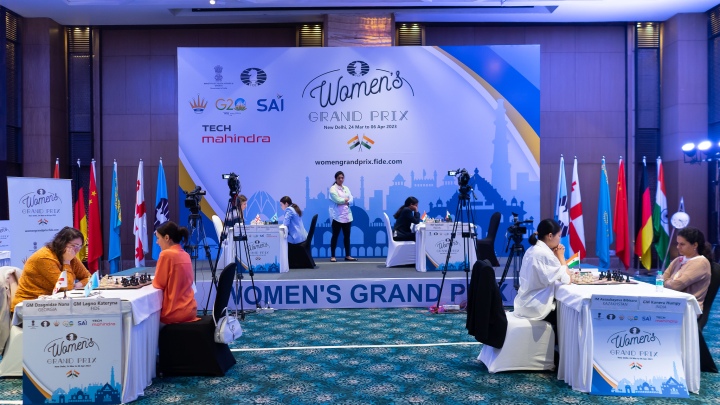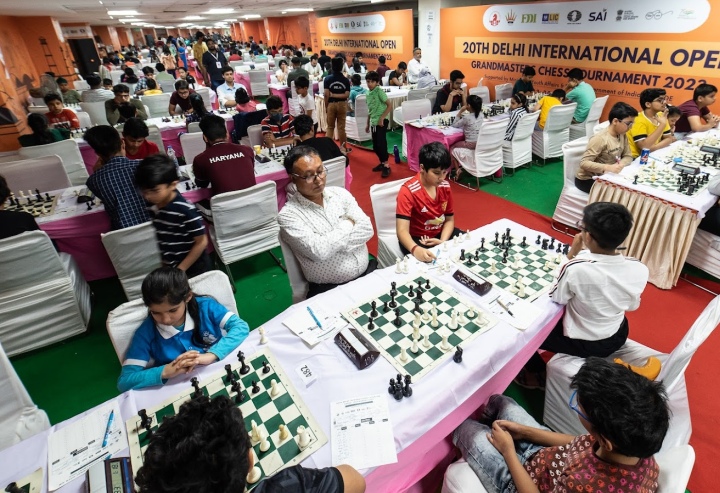WGP New Dehli: Round 7 Recap

Bibisara Assaubayeva made her first draw in New Delhi but is still in the lead with 4,5 points. The race for the top is heating up as both Lagno and Goryachkina scored Round 7 saw two decisive outcomes and two draws. It was a relatively short round, with the last game finishing after three and a half hours of play. Round 7 results: Nana Dzagnidze – Kateryna Lagno, 0 – 1Bibisara Assaubayeva – Humpy Koneru, ½ – ½Vaishali Rameshbabu – Harika Dronavalli – ½ – ½Nino Batsiashvili – Aleksandra Goryachkina – 0 – 1 In the seventh round of the Women’s Grand Prix in New Delhi, Bibisara Assaubayeva made her first draw of the event against Humpy Koneru, playing the Reversed Benoni. Although Assaubayeva had a better position, she couldn’t find a path to victory. Despite this, the player from Kazakhstan still leads the tournament with 4,5 out of 6 points. Koneru has three points. Meanwhile, Aleksandra Goryachkina took another step towards the top, capitalizing on a blunder by Nino Batsiashvili in Veresov. Kateryna Lagno also had a successful match against Nana Dzagnidze, taking advantage of Nana’s misplay in the Bogo-Indian to secure a win. Lagno and Goryachkina both have 3,5 points, but Goryachkina has one game more. The Indian derby between Harika Dronavalli and Vaishali Rameshbaby, ended in a draw. Vaishali has 1,5 points while Harika has two. Here follows a more detailed look at the games of Round Seven in the Women’s Grand Prix: Nana Dzagnidze – Kateryna Lagno In the huge number of games the two have played, Lagno leads by a significant margin. Nana forgot her moves in the opening and spent a lot of time in a rare line of the Bogo-Indian. Kateryna sacrificed a pawn early on and got some compensation but hardly more. On her fourteenth move, however, Dzagnidze made a serious mistake. Here White should play 14.a3, but Nana forgot the line and played 14.f4? allowing Black to create a strong pawn centre and obtain a serious space advantage, which Kateryna used to align her pieces for the attack. After due preparation, Black started her onslaught on the white king. Nana had just one way to stay in the game for a while by putting her rook on f1, to protect and control the f4 square. Instead, she played 23.Qc2?, allowing Black to open the g-file with deadly threats. 23…gxf4 24.gxf4 Qh4 – White has no escape. The final portion of the game turned into a hunt for the White’s king that ended on move 29. Leaving the playing hall, Nana Dzagnidze briefly commented that “one can’t play when they forget or don’t know the lines”. Despite a challenging tournament, Nana Dzagnidze is maintaining a courageous demeanour and refraining from displaying any overtly negative emotions. Lagno now has four points, while Dzagnidze is on two. Bibisara Assaubayeva – Humpy Koneru This was the first classical game between Assaubayeva and Koneru. So far, they have played 23 Blitz games with an even head-to-head record. Just like in the encounter between Assaubayeva and Dronavalli, the game saw the Reversed Benoni and, again, White emerged clearly better in the opening. In the post-game analysis, Koneru explained that here she misplayed the line – she should have continued with 10…c6 but played 10…Re8. Bibisara had an extra pawn with no visible compensation for Black. On move 16, White had a chance to increase her advantage by grabbing the b7-pawn but Assaubayeva opted for a safer approach. Little by little, Koneru coordinated her pieces and countered by pushing the a-pawn and then activating her kingside pieces, to force exchanges and blunt White’s edge. Despite not finding the best moves, White had a better position for most of the game, although to Koneru’s credit, she put up a stubborn resistance. In the end, as both reached time trouble, it all turned around as Assaubayeva handed her advantage to Black. Sensing the moment, Assaubayeva made a good practical decision by offering a draw in the following position after 37.f3 Koneru was better here: Black just needs to realign her heavy pieces on the kingside and put pressure on White’s centre. However, Humpy was not in the mood to continue, and the two agreed to split a point. This is the first draw for Bibisara Assaubayeva who now has 4,5 points out of six games. Humpy Koneru has three points. Vaishali Rameshbabu – Harika Dronavalli In the Indian duel between Vaishali and Harika, out of 17 games played between the two, Vaishali won nine, and Harika won eight. In the Open variation of the Ruy Lopez, the opponents tested a rare line and quickly stepped off the beaten track. Both played quite logical natural moves keeping position in balance. Following exchanges and simplifications, the two reached an even rook endgame and called it a day. Dronavalli is on two points while Rameshbaby is on 1,5. Nino Batsiashvili – Aleksandra Goryachkina Out of the total of 13 games the two have played so far, Nino has two wins and Goryachkina has four. In the Veresov with 3.Bf4, the two entered unchartered waters as early as move six. Batsiashvili went for an unusual move 6.Nh3 but after natural 6…Bb4 played by Goryachkina, Black was already slightly better. A more logical move was 6.h4, heading into a sharp position. After Nino closed the centre on move eight, Aleksandra got a very good version of advanced Karo-Cann with a couple of White’s pieces misplaced. White’s uncastled king is exposed, and the centre is hanging by a thread. White should have proceeded with 13.dxc5 to remove the c5 pawn, countering Black on the left flank and centre. Instead, 13.b4 played in the game was premature and, costly. After the game, Nino explained that the occasional noise coming from another part of the hotel affected her concentration, and she misplayed. After 13…cxb4, instead of taking 14.axb4 and continuing resistance in a worse position, Nino played 14.Nb5? – a well-known idea in the French Defence, that just doesn’t work here. It failed to 14…Bxc2! 15.Qxc2 b3+ 16.Qd2
Aravindh Chithambaram wins 20th edition of New Delhi Open

The 20th edition of the spectacular New Delhi Open, in which 1057 players took part, ended with the victory of Indian GM Aravindh Chithambaram, while GM Luka Paichadze of Georgia finished as first runner up. In what is in the West now, mostly a memory from the heyday of chess popularity, India has hosted its biggest tournament – the New Delhi Open – in a stadium. The jubilar 20th edition of the New Delhi Open (started in 2003) took place at the Jawaharlal Nehru Stadium, named after the first Prime Minister of India, and is the fourth biggest stadium in the country. Traditionally, the tournament is held at the Indira Gandhi Stadium, the largest indoor sports arena in the country, but due to the World Women’s Boxing Championship, it had to be moved. The New Delhi Open has become a beacon for chess enthusiasts around India, attracting nearly 3000 players annually. The event has three different categories: one is the GM Open, then B category, below 1999 rating, and C category, below 1599. While the event traditionally takes place every January, due to the rise in Covid cases in India at the start of the year, it was postponed. The initial prize fund was $153,000 in three categories, but due to health and safety, the organisers decided to have the event in just one – top category, with a prize fund of $55,000. Altogether, 19 Grandmasters and a number of IMs and FMs from over 10 countries took part in the event. The second seed Aravindh Chithambaram (India, pictured below), turned in an excellent performance and came out on top, scoring a spectacular 9.5/10. Luka Paichadze (Georgia) finished just a half-point behind the winner. As many as six participants netted 8.5/10, with the top seed GM Sethuraman S P (India) taking third place thanks to superior Buchholz. The excitement at the New Delhi Open was further amplified as it coincided with the third leg of the Women’s Grand Prix. The atmosphere was electrifying as both events showcased the very best of chess. “India has become a chess nation, and the New Delhi Open is a beacon of our success. With numerous Grandmasters and thousands of young players participating from all corners of the country, this event has become an annual celebration of our love for the game. And with the successful hosting of the Olympiad, we are committed to promoting chess in India and transforming our country into a true superpower in chess,” said Bharat Singh, Director of the New Delhi Open and a key figure in the All India Chess Federation. Final standings: 1 GM Aravindh, Chithambaram IND 2607 9½ 2 GM Paichadze, Luka GEO 2515 9 3 GM Sethuraman, S.P. IND 2639 8½ 4 GM Savchenko, Boris FID 2552 8½ 5 GM Kobalia, Mikhail FID 2577 8½ 6 AIM Vaz, Ethan IND 1949 8½ 7 GM Krasenkow, Michal POL 2527 8½ 8 GM Aleksandrov, Aleksej FID 2484 8½ 9 GM Murzin, Volodar FID 2554 8 10 GM Mchedlishvili, Mikheil GEO 2569 8 The top eight finishers of the New Delhi Open earned FIDE Circuit race points based on the final standings: 1. 7,99 2. 6,39 3. 4,59 4. 4,19 5. 3,79 6. 3,39 7. 3,00 8. 2,60 Complete results Text: Milan Dinic Photo: Ismael Nieto

